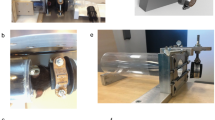Summary
The concept of shearing of axons at the time of non-impact injury to the head was first suggested in the middle of this century. However, no experimental model of diffuse axonal injury (DAI) has provided morphological confirmation of this concept. Evidence from experiments on invertebrate axons suggests that membrane resealing after axonal transection occurs between 5 and 30 min after injury. Thus, ultrastructural evidence in support of axonal shearing will probably only be obtained by examination of very short-term survival animal models. We have examined serial thin sections from the corpus callosum of non-human primates exposed to lateral acceleration of the head under conditions which induce DAI. Tearing or shearing of axons was obtained 20 and 35 min after injury, but not at 60 min. Axonal fragmentation occurred more frequently at the node/paranode but also in the internodal regions of axons. Fragmentation occurred most frequently in small axons. Axonal shearing was associated with dissolution of the cytoskeleton and the occurrence of individual, morphologically abnormal membranous organelles. There was no aggregation of membranous organelles at 20 and 35 min but small groups did occur in some axons at 60 minutes. We suggest that two different mechanisms of injury may be occurring in non-impact injury to the head. The first is shearing of axons and sealing of fragmented axonal membranes within 60 min. A second mechanism occurs in other fibres where pertubation of the axon results in axonal swelling and disconnection at a minimum of 2 h after injury.
Similar content being viewed by others
References
Adams JH, Doyle D, Ford I, Graham DI, McLellan D (1989) Diffuse axonal injury in head injury: definition, diagnosis and grading. Histopathology 15:49–59
Ballentine JD (1988) Spinal cord trauma: in search of the meaning of granular axoplasm and vesicular myelin. J Neuropathol Exp Neurol 47:77–92
Banik NL, Hogan EL, Powers JM, Smith KP (1986) Proteolytic enzymes in experimental spinal cord injury. J Neurol Sci 73:245–256
Erb DE, Povlishock JT (1988) Axonal damage in severe traumatic brain injury: an experimental study in cat. Acta Neuropathol 76:347–358
Gennarelli TA, Thibault LE (1982) Biomechanics of acute subdural hematoma. J Trauma 22:680–686
Gennarelli TA, Thibault LE, Adams JH, Graham DI, Thompson CJ, Marcincin RP (1982) Diffuse axonal injury and traumatic coma in the primate. Ann Neurol 12:564–574
Gennarelli TA, Thibault LE, Tipperman R, Tomei G, Sergot R, Brown MD, Maxwell WL, Graham DI, Adams JH, Gennarelli LM, Duhaime AC, Boock RS, Greenberg J (1989) Axonal injury in the optic nerve: a model simulating diffuse axonal injury in the brain. J Neurosurg 71:244–253
Graham DI, Adams JH, Logan S, Gennarelli TA, Thibault LE (1985) The distribution, nature and time course of diffuse axonal injury. Neuropathol Appl Neurobiol 11:319
Holbourn AHS (1943) Mechanics of head injuries. Lancet II 438–441
Lighthall JW, Goshgarian HG, Pinderski CR (1990) Characterization of axonal injury produced by controlled cortical impact. J Neurotrauma 7:65–76
Margulies SS, Thibault LE, Gennarelli TA (1990) Physical model simulations of brain injury in the primate. J Biomech 23:823–836
Maxwell WL, Kansagra AM, Graham DI, Adams JH, Gennarelli TA (1988) Freeze-fracture studies of reactive myelinated nerve fibres after diffuse axonal injury. Acta Neuropathol 76:395–406
Maxwell WL, Irvine A, Graham DI, Adams JH, Gennarelli TA, Tipperman R, Sturatis M (1991) Focal axonal injury: the early axonal response to stretch. J Neurocytol 20:157–164
Maxwell WL, Whitfield PC, Suzen B, Graham DI, Adams JH, Watt C, Gennarelli TA (1992) The cerebrovascular response to experimental laterla head acceleration. Acta Neuropathol 84:289–296
Meiri H, Dormann A, Spira ME (1983) Comparison of ultrastructural changes in proximal and distal segments of transected giant fibers of cockroach Periplaneta americana. Brain Res 263:1–14
Murachi T (1983) Calpain and calpastatin. Trends Biochem Sci 8:167–169
Peerless SJ, Rewcastle NB (1967) Shear injuries of the brain. Can Med Assoc J 96:577–582
Povlishock JT (1986) Traumatically induced axonal change without concomitant change in focally related neuronal somata and dendrites. Acta Neuropathol (Berl) 70:53–79
Povlishock JT (1992) Traumatically induced axonal injury: Pathogenesis and pathobiological implications. Brain Pathol 2:1–12
Povlishock JT, Becker DP, Cheng C, Vaughan G (1983) Axonal change in minor head injury. J Neuropathol Exp Neurol 42:225–242
Rydmark M (1981) Nodal axon diameter correlates linearly with internodal axon diameter in spinal roots of the cat. Neurosci Lett 24:247–250
Ommaya AK, Gennarelli TA (1974) Cerebral concussion and traumatic unconciousness. Correlation of experimental and clinical observations on blunt head injuries. Brain 97:633–654
Strich S (1956) Diffuse degeneration of the cerebral white matter in severe dementia following head injury. J Neurol Neurosurg Psychiatry 19:63–185
Strich S (1961) Shearing of nerve fibres as a cause of brain damage due to head injury. Lancet II:443–448
Waxman SG, Black JA, Stys PK, Ransom BR (1992) Ultrastructural concomitants of anoxic injury and early post-anoxic recovery in rat optic nerve. Brain Res 574:105–119
Yaghmai A, Povlishock JT (1992) Traumatically induced reactive change as visualized through the use on monoclonal antibodies targeted to neurofilament subunits. J Neuropathol Exp Neurol 51:158–176
Yawo H, Kuno M (1983) How a nerve fiber repairs its cut end: involvement of phospholipase A2. Science 222:1351–1352
Yu QC, McNeil PL (1992) Transient disruptions of aortic endothelial cell plasma membranes. Am J Pathol 141:1349–1360
Author information
Authors and Affiliations
Additional information
Dedication: The authors would like this work to be a tribute to Professor J. H. Adams upon his retiral. His research into diffuse axonal injury inspired the authors to undertake this study.
Supported by NIH grant number NS-08803-21, the Wellcome Trust, the Royal Society, London and the Institute of Neurological Sciences, University of Glasgow. Part of this work was presented at the Ist International Neurotrauma Symposium, Fukishima, Japan and the IVth European Meeting of Neuropathology, Berlin
Rights and permissions
About this article
Cite this article
Maxwell, W.L., Watt, C., Graham, D.I. et al. Ultrastructural evidence of axonal shearing as a result of lateral acceleration of the head in non-human primates. Acta Neuropathol 86, 136–144 (1993). https://doi.org/10.1007/BF00334880
Received:
Revised:
Accepted:
Issue Date:
DOI: https://doi.org/10.1007/BF00334880




